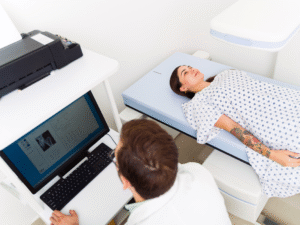Summary
Uncontrollable urine leakage is often called urinary incontinence or “leaky bladder” and it can affect anyone. Dr. Allison Polland discussed the causes of incontinence and ways that you can address it.
Listen on Spotify Listen on Apple Podcasts Listen on Google Podcasts
Transcript
Joey Wahler (Host): Uncontrollable urine leaking is often called urinary incontinence or a leaky bladder. It affects many men and women, but is far more common in females. So we’re discussing what causes incontinence and how it’s addressed.
This is Maimo Med Talk, I’m Joey Wahler. Our guest, Dr. Allison Polland, a Urologist and Urogynecologist and Director of the Maimonides Pelvic Floor Center. Dr. Polland, thanks for joining us.
Allison Polland, MD (Guest): Thank you for having me.
Host: Well, first, what are the symptoms of urinary incontinence?
Dr. Polland: So, urinary incontinence is any sort of leakage of urine. And there’s really two kinds of incontinence. There’s the kind of incontinence which is called urge urinary incontinence, which is I’m rushing to the bathroom and I just don’t make it in time. And then there’s the kind of incontinence called stress urinary incontinence, which is I sneezed and a little pee came out.
Host: And why is it? We alluded to it a moment ago that incontinence is so much more prevalent in women than in men. And what’s the age range we’re usually talking about people being affected most at?
Dr. Polland: So both men and women can have incontinence, but women do have a shorter urethra than men. And, a lot of women will end up with urinary incontinence. And there’s not a specific age, although there are certain things that make urinary incontinence more common. So it is more common with age. It’s also, especially stress incontinence is more common after childbirth. And I see women of all ages. I see women, you know, in their twenties. I see women in their sixties. I see women in their nineties and I try to come up with the right treatment plan for each woman depending on her symptoms and what her goals are.
Host: So you mentioned there some women suffering from this after childbirth. Is that typically temporary? Can that usually be addressed?
Dr. Polland: So incontinence after childbirth, is often temporary and it can be addressed. And we actually are starting a great program here at Maimonides. It’s called the PEARL program or the postpartum exercise and recovery liaison program. And it’s for women who deliver here at Maimonides or elsewhere, to address pelvic floor issues immediately after childbirth. And we are offering these women an opportunity to be seen by a urogynecologist. They will have the access to a transperineal pelvic floor ultrasound, which is something really unique. And we are the only place in Brooklyn that is offering that. And then we will be able to get them into the treatment they need. And oftentimes it’s pelvic floor physical therapy. And we can offer that here at Maimonides and that can get these women back to being dry as quickly as possible.
Host: Interesting. So you talk there about treating new moms, I’m going to ask you about some of the other treatments for people in general, in a moment, but before we go any further, you do also have incontinent male patients. So any main difference, generally speaking, in treating men and women with this condition?
Dr. Polland: A lot of men will develop incontinence after a prostate surgery and most commonly that’s a radical prostatectomy for prostate cancer. And the incontinence is also often short-lived, especially with the newer nerve sparing techniques for radical prostatectomy. And for those men, the same idea of pelvic floor therapy getting involved in doing those exercises early on, can help shorten the period of time that they’re incontinent afterwards. Then for those patients who the exercises are not enough, and this is true of both men and women, there are surgical treatments as well.
Host: So, unless it’s something acute and you’ve mentioned a few of those things or age, and you’ve mentioned that, is there anything else that’s commonly the cause of incontinence?
Dr. Polland: There are some behavioral things that patients may not realize that can really cause worsening incontinence. And usually that’s about urgency incontinence. And so caffeine is sort of a double whammy. It is a diuretic, which means it makes you make extra urine. And it’s also a bladder irritant. So once that urine hits the bladder, it makes you feel like you really have to go. And so people may not realize that caffeine is present in coffee. It’s presently in a lot of teas, it’s present in soda. And some patients may not recognize that when you are having so much caffeine, you end up making yourself go to the bathroom a lot more than would be usual.
And sometimes it’s just a matter of urine volume. There’s no specific rule that says you have to drink eight glasses of water a day. I usually say drink when you’re thirsty. And that’s because your body is really good at telling you when you need more liquid to be hydrated. And some people over-drink, whether they’re trying to do it to lose weight or because they like the caffeine to stay awake, they end up drinking much more than is necessary. And then they have to go to the bathroom all the time. And sometimes when you’re rushing to the bathroom, you can’t make it.
Host: Interesting. I think you hit on a number of things that many of us are guilty of there, unfortunately. Let’s talk about some of the various incontinence treatments. You hit on one a little bit earlier. Maybe expand on it Doctor, if you could please, starting with pelvic floor muscle therapy.
Dr. Polland: Okay. I’m going to go through the treatments for incontinence based on the types of incontinence. So let’s start first with overactive bladder, which is that urgency incontinence when you’re rushing to the bathroom and you just don’t make it in time. So step one is making sure you’re not drinking too much coffee. It’s also doing some timed voiding, so some people just get in the bad habit of every time they think, oh, I might need to go. They just go to the bathroom. And then your bladder just gets in a bad habit of going to pee all the time. And you end up going every one hour, but if you were to push yourself and say, you know what, I’m going to push it to an hour and 15 minutes or an hour and a half, little by little, you can actually train your bladder to hold the urine for a little bit longer.
On the flip side, there are patients who have done this subconsciously or, you know, or over the years and they are going to six hours. So they’re pushing their bladder further and further. And that’s just too much because at some point your bladder will stop giving you the signals of, I need to go when it’s a reasonable time and it’ll wait till it’s too late. And then you’ll have the urge incontinence on your way running to the bathroom. It’s normal to go about every three to four hours and making sure that you can train your bladder to go around that timeframe and not too quickly and not waiting too long, I think is a big part of it. That’s the behavioral treatment.
The next treatment is medications, there are different kinds of medication for rushing to the bathroom. The old fashioned kinds or the anticholinergics, and those are still very good medications, but they sometimes cause dry mouth or constipation and they can even cause confusion in the elderly. So I try to avoid those in the elderly. And instead I give the beta agonist medications and those don’t cause those issues and there are newer medication and they’re really very effective. For patients who medication doesn’t work for it, there are sort of three next line treatment options. One is PTNS or percutaneous tibial nerve stimulation. And that is an acupuncture type treatment where you come in every week for 12 weeks and a tiny acupuncture needle goes in the ankle and it stimulates the same nerves that go to the bladder to help relax the bladder. And that works just as well as medication. So, it’s a good option for patients who are worried about side effects of medication and have the time to come in for a weekly treatment.
The next option is Botox to the bladder. So just like Botox is used for the muscles in the face that can cause the wrinkles, Botox can be used for the muscle in the bladder that causes overactive bladder and it can help to stretch out the bladder and help with the urgency so that you don’t have that same leaking.
And then the last option is a sacral neuromodulation device. And that’s basically like a pacemaker for the bladder. There are wires that go under the skin by the butt cheeks and they go to the nerves that go to the bladder that help relax the bladder. And the great thing about that is whether your bladder is squeezing too much or not squeezing enough, this pacemaker type device can help it to normalize it so that you’re going to the bathroom regularly.
Host: And how about surgery? Is that ever needed?
Dr. Polland: The surgery is more often needed for stress urinary incontinence. So, so far we’ve talked about the urgency incontinence and the next thing I’m going to talk about is the stress incontinence. So stress incontinence, the first step for that is that pelvic floor exercise. And there are different ways that you can do it. Some people will just do those Kegel exercises at home. And I know this is going to sound funny, but the way I like to explain that to women is imagine squeezing your vagina and pulling it up to your belly button. It’s really a squeeze and lift. And that’s something that you can do every single day. If you do it, when you brush your teeth, you’re not going to forget, and you can do it twice a day and you know, 10 times each time.
And that can really make a difference, especially if you feel like a sneeze is coming on. If you squeeze and then sneeze, you’re less likely to leak. The other thing that you can do in terms of pelvic floor exercises is you can do something called biofeedback where we’ll put a machine that can help you identify the pelvic floor muscles you need to squeeze, and it will help you to stimulate those muscles with an electrical stimulation.
And we also have pelvic floor physical therapy where you’ll work with a physical therapist, who’s done additional training in the muscles of the pelvic floor to work on things that may seem unrelated, like your balance and your gait, but all of those things put together can make a big difference for the pelvic floor.
That’s sort of the conservative option for the stress urinary incontinence. The surgical options for stress urinary incontinence is there is a injection called a urethral bulking injection. And that’s actually something we can do in the office. But if you think of it as if the urethra is too wide open, and so that’s why you’re leaking urine. Again, the urethra is the tube where the urine comes out.
If that’s too wide open, well, then you need to close it. So, the exercises are to squeeze the muscles around the urethra and that can close it, but another way to close it would be a bulking injection. And this is using filler, very similar to the filler people use when they’re injecting fillers to make their lips look bigger, you can put filler around the outside of the urethra and that makes i the hole smaller, so you’re less likely to leak. And it’s a great option for people who don’t want to go to the operating room, but still want a procedure to fix the leaking. It does need to be repeated though. It lasts for a few years, but then it needs to be repeated. For somebody who wants a durable repair, then I would recommend a mid-urethral sling. That is a piece of plastic fabric or mesh that goes under the urethra to hold it closed when somebody coughs or sneezes and this is mesh, but it’s not the vaginal mesh for prolapse that was banned by the government. That was a much bigger piece of mesh. This is a tiny piece of mesh, smaller than a shoelace, and it’s not holding tension on anything. It’s placed in a way that it’s only working when you cough and sneeze. So it doesn’t have the same risks that a mesh placed for prolapse transvaginally did.
And that’s why that was banned by the government. For men, there are similar options for the stress incontinence. The first option being those pelvic floor exercises. And for men, there’s also a sling option. The sling in men is a very good option for someone who doesn’t have a lot of leakage, but it’s still wearing a pad for urine leakage. And then the last option for men is a artificial urinary sphincter. And that is a device that is put around the urethra. Again, the urethra is the urine tube and that helps to hold the urine in. And that’s for men who have a significant amount of urinary incontinence.
Host: Wow. Well, certainly a number of options, no matter what’s causing the problem. So interesting to know that a couple of other things I want to ask you though, both women and men often are embarrassed about being incontinent and maybe about seeking medical help. What would you tell them as an expert in this?
Dr. Polland: There is nothing to be embarrassed about. There are a lot of people who come see me for this. There are a lot of people who have this and don’t seek treatment because they think it’s normal. And I think I want to stress that, yes, this is common, but just because it’s common doesn’t mean it’s normal and doesn’t mean that you have to live with it. This is something that is very treatable.
Host: And Maimonides which is really interesting, has Brooklyn’s only Pelvic Floor Center. It’s one of a kind. So that really puts the special in specialist. What makes your facility stand out the most would you say?
Dr. Polland: There are various hospitals that might have a urologist who does this, or might have a gynecologist or a urogynecologist that does this, but what’s so great about Maimonides is we really have a multidisciplinary pelvic floor center. So, this is a team that includes a urologist, a urogynecologist, a general gynecologist, as well as colorectal surgeons and pelvic floor physical therapists.
And the idea of having this multidisciplinary team is that no matter what kind of leakage you’re having, and today we’re focusing on urinary incontinence, but we also treat people who have fecal incontinence; no matter what’s going on, you know that there’s a one-stop shop that can help you. And we are not just surgeons. We are not only offering one thing. We’re offering the whole range of treatments. So if you want to try something conservative, we have the physical therapist for that. You want to have surgery. We have the expert surgeons for that. It’s really one place where we can deal with all of your pelvic floor needs. We see both men and women and we address the full spectrum of pelvic floor issues..
Host: Indeed. So in closing, folks, you now know, no matter what the cause of your incontinence is, no matter what type, whether you’re male or female, as Dr. Polland put it, a one-stop shop at Maimonides to cater to any of those needs. Dr. Allison Polland, very informative. Thanks so much again.
Dr. Polland: Thank you for having me.
Host: And to make an appointment at the Maimonides Pelvic Floor Center, please call 718-PELVIC1. That’s 718-PELVIC1. For more info
Joey Wahler: maimo.org.
Host: If you found this podcast helpful, please do share it on your social media.
And thanks for listening to Maimo Med Talk, Hoping your health is good health. I’m Joey Wahler.







